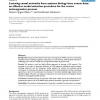980 search results - page 132 / 196 » Smoothing Gene Expression Using Biological Networks |
RECOMB
2004
Springer
14 years 8 months ago
2004
Springer
We present new methods for reconstructing reticulate evolution of species due to events such as horizontal transfer or hybrid speciation; both methods are based upon extensions of...
BMCBI
2007
13 years 7 months ago
2007
Background: The underlying goal of microarray experiments is to identify gene expression patterns across different experimental conditions. Genes that are contained in a particula...
BMCBI
2007
13 years 7 months ago
2007
Background: Causal networks based on the vector autoregressive (VAR) process are a promising statistical tool for modeling regulatory interactions in a cell. However, learning the...
BIBM
2008
IEEE
14 years 2 months ago
2008
IEEE
We adapt a network simulation algorithm called quantitative simulation (QSim) for use in the alignment of biological networks. Unlike most network alignment methods, QSim finds l...
BMCBI
2010
13 years 7 months ago
2010
Background: Alternative splicing is an important mechanism that increases protein diversity and functionality in higher eukaryotes. Affymetrix exon arrays are a commercialized pla...

